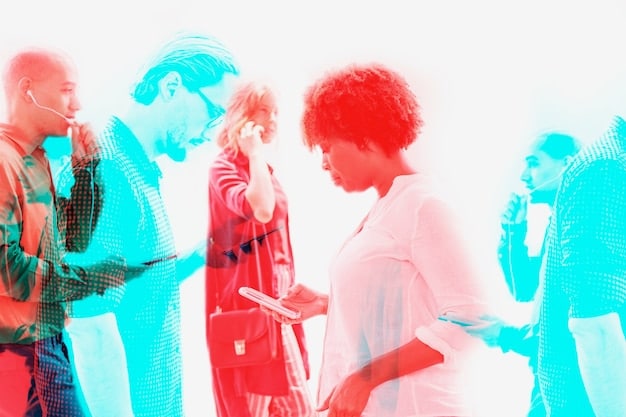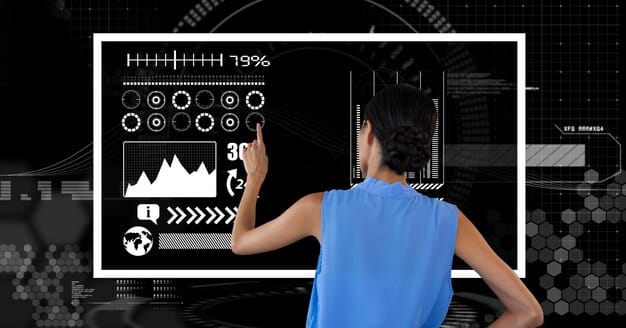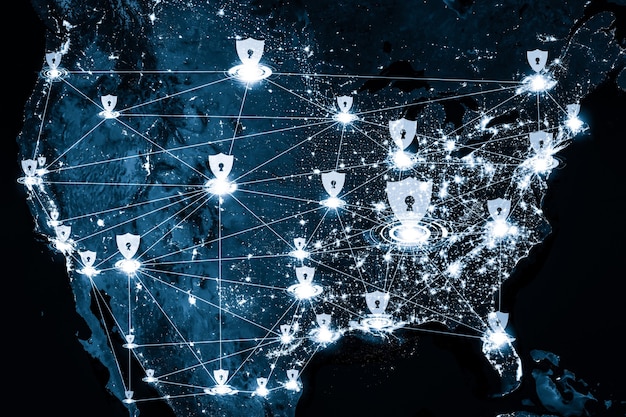The Future of Inclusive Communication: 3 Predictions for 2025 and Beyond

The future of inclusive communication, by 2025 and beyond, will be shaped by the widespread integration of AI-powered personalization, a greater emphasis on sensory diversity, and the expansion of global digital literacy initiatives to ensure equitable access and engagement for all.
In an increasingly interconnected world, the ability to communicate effectively and inclusively is not just a desirable trait—it is a fundamental necessity. As technology continues its relentless march forward and societal understanding of diversity deepens, we stand at the cusp of a profound transformation in how we interact. This article delves into the exciting realm of The Future of Inclusive Communication: 3 Predictions for 2025 and Beyond, exploring how evolving paradigms will reshape our digital and physical interactions.
Understanding the Foundation: What Is Inclusive Communication?
Inclusive communication refers to the practice of ensuring that information is conveyed in a way that can be understood and accessed by everyone, regardless of their abilities, background, or communication preferences. It’s about breaking down barriers and fostering an environment where every voice can be heard and every message received. This principle extends beyond mere accessibility and delves into the nuance of understanding diverse cognitive, physical, and sensory needs.
Building truly inclusive communication systems requires a multidisciplinary approach, blending technological innovation with deep empathy and understanding of human diversity. It’s an ongoing evolution, driven by both technological advancements and a growing societal commitment to equity.
The Historical Context of Communication Barriers
For centuries, communication has inherent barriers, often inadvertently excluding large segments of the population. From relying solely on written text to overlooking auditory or visual impairments, traditional communication methods frequently failed to adapt to diverse needs. The advent of mass media, while democratizing information in some ways, often perpetuated these exclusions through standardized formats.
- Print Dominance: Historically, lack of braille, large print, or screen reader compatibility left visually impaired individuals behind.
- Auditory Reliance: Radio and early television primarily catered to those with hearing, leaving deaf individuals underserved.
- Digital Divide: Early internet access created a new barrier for those without technology or digital literacy.
Recognizing these historical shortcomings is crucial for truly building inclusive communication pathways for the future. It underscores the urgency of proactive design rather than reactive accommodation.
The journey towards inclusive communication has been propelled by advocacy, legislation, and technological breakthroughs. From the development of Braille and sign languages to the more recent innovations in assistive technologies, each step has brought us closer to a more equitable communication landscape. Understanding this trajectory helps us appreciate the scale of the changes anticipated in the coming years and beyond 2025.
Prediction 1: Hyper-Personalized AI-Driven Interfaces
One of the most transformative shifts we anticipate by 2025 and beyond is the widespread adoption of hyper-personalized, AI-driven communication interfaces. These aren’t just smart assistants; they are sophisticated systems capable of adapting communication in real-time to an individual’s unique cognitive, sensory, and linguistic needs. Imagine a world where every digital interaction automatically adjusts its format, language, and complexity to suit you perfectly.
These interfaces will leverage advanced machine learning to analyze user preferences, past interactions, and real-time biometric data to offer truly customized communication experiences. This means a seamless translation between spoken word, text, sign language, haptic feedback, and even emotional tone, all tailored to the recipient. The goal is to eliminate the ‘one-size-fits-all’ approach, which invariably excludes someone.
Real-time Cognitive and Sensory Adaptation
AI will move beyond simple text-to-speech or speech-to-text. It will begin to understand and respond to subtler cues. For instance, if a user has a cognitive processing difference, an interface might automatically simplify complex sentences, provide visual aids, or add pauses for better comprehension. For individuals with sensory sensitivities, haptic feedback might replace auditory alerts, or visual displays could adjust brightness and contrast on the fly.
- Dynamic Content Simplification: AI algorithms will rephrase complex information into simpler terms or offer tiered explanations.
- Multi-modal Output Generation: Information instantaneously rendered into text, audio, sign language avatar, or tactile feedback.
- Contextual Emotion Recognition: Interfaces could detect user frustration and offer alternative communication methods or support.
This level of personalization requires robust data privacy frameworks and ethical AI development, ensuring that these powerful tools are used for empowerment, not surveillance or discrimination. The challenge lies not just in developing the technology, but in implementing it responsibly.

The beauty of such systems lies in their potential to create a truly barrier-free digital ecosystem. No longer will individuals need to seek out specific accessibility tools; the platforms themselves will natively adapt, making inclusive communication the default, not an add-on. This paradigm shift holds immense promise for education, employment, and social connection.
Prediction 2: The Rise of Sensory Diverse Communication Ecosystems
Beyond traditional visual and auditory communication, 2025 and beyond will see a significant expansion into designing communication ecosystems that embrace a wider spectrum of human sensory experiences. This involves integrating touch, smell, and even proprioception (the sense of body position) into how we convey and receive information. This is particularly relevant for individuals with profound sensory impairments or those who process information optimally through non-traditional channels.
Imagine virtual reality environments that convey information through haptic suits, allowing users to “feel” vibrations of a speaker’s voice, or interactive installations that use scent cues to guide navigation or evoke memories. This multi-sensory approach aims to create richer, more immersive, and more universally accessible communication experiences.
Haptic Feedback and Tactile Interfaces
Haptic technology, already present in smartphones and gaming controllers, will evolve dramatically. We’ll see sophisticated haptic interfaces that can convey complex information through patterns of vibration, pressure, and temperature. This could be instrumental for users who are deafblind, allowing them to “read” conversations or navigate environments through touch alone.
Tactile displays, capable of rendering dynamic textures and shapes, will emerge as a powerful tool for visual and spatial communication, offering an unprecedented level of detail for non-visual learners. The integration of advanced haptics could revolutionize areas like virtual meetings, educational content, and even artistic expression.
This expansion into sensory diversity moves beyond simply providing alternatives for impaired senses. It seeks to unlock new dimensions of communication for everyone, recognizing that human perception is multifaceted. By designing for the extremes, we often create better experiences for the mainstream.
The ethical implications of manipulating sensory input will also need careful consideration, ensuring these technologies are used to enhance human connection and understanding, not to mislead or overwhelm. The focus remains on empowerment and increased accessibility for all.
Prediction 3: Global Digital Literacy and Infrastructure Equity
While technological advancements are exciting, their impact on inclusive communication hinges on equitable access and digital literacy. By 2025, and increasingly beyond, there will be a concerted global effort to bridge the digital divide and ensure that everyone, regardless of socioeconomic status or geographic location, has the tools and knowledge to participate in the interconnected world. This prediction recognizes that technology developed without equitable access remains inherently exclusive.
This isn’t merely about providing internet access; it’s about fostering the skills and understanding necessary to navigate complex digital environments, utilize inclusive communication tools, and protect oneself online. This global initiative will involve public-private partnerships, educational reforms, and community-led programs focused on digital empowerment.
Universal Basic Infrastructure and Education
Governments and NGOs will likely prioritize universal broadband access, viewing it as a fundamental human right akin to electricity or water. This will be coupled with educational programs tailored to different age groups and communities, teaching not just how to use devices, but how to critically evaluate information, engage respectfully, and leverage inclusive features. The focus will shift from mere access to effective participation.
Localized and culturally sensitive digital literacy training will be essential, recognizing that different communities have unique learning styles and needs. This grassroots approach will ensure that the benefits of advanced communication technologies are distributed as widely as possible, preventing new forms of digital exclusion. Without these foundational elements, the promises of AI and sensory communication remain largely unfulfilled for billions.
- Community Technology Hubs: Establishment of accessible community centers with free internet, devices, and training.
- Simplified User Interfaces: Development of highly intuitive and customizable operating systems for first-time or low-literacy users.
- Multilingual Digital Resources: Creation of educational content in local languages, explaining digital concepts clearly.
The commitment to digital literacy and infrastructure equity represents a vital ethical consideration in the future of inclusive communication. It acknowledges that technology alone is not a panacea; it must be coupled with human-centered policy and outreach to truly serve all of humanity. The future of communication is inclusive only if it reaches everyone.
Challenges and Ethical Considerations in Communication Evolution
As we race towards a future of hyper-personalized, sensory-rich, and universally accessible communication, it is crucial to acknowledge the inherent challenges and ethical considerations that accompany such profound advancements. Innovation without introspection can lead to unintended consequences, potentially creating new forms of exclusion or privacy risks. A proactive approach to these issues is paramount.
One primary concern revolves around data privacy and security. AI-driven personalization relies heavily on collecting vast amounts of personal data, including sensitive information about cognitive and sensory preferences. Ensuring this data is protected from misuse, breaches, or discriminatory practices will be a monumental task requiring robust regulatory frameworks and transparent data handling policies. Users must retain ultimate control over their communication profiles.
Another challenge is the potential for technological obsolescence and the continuous need for updates. As communication tools become more sophisticated, maintaining interoperability and ensuring that older devices or less-resourced communities are not left behind will be an ongoing struggle. The “digital divide” could transform into a “digital competence divide” if not managed carefully.
Navigating the Ethics of AI in Communication
The role of AI in shaping our communication brings forth complex ethical dilemmas. How do we ensure AI models are free from biases that could inadvertently misrepresent or even silence certain voices? The algorithms must be trained on diverse datasets and regularly audited for fairness and equity. Transparency in AI decision-making processes will be crucial for building trust and accountability.
- Algorithmic Bias: Ensuring AI models do not perpetuate or amplify existing societal biases in communication interpretation or generation.
- Deepfakes and Misinformation: Developing robust defenses against the malicious use of AI to generate deceptive communication.
- Human Oversight: Maintaining a balance between automation and the role of human judgment in critical communication scenarios.
Moreover, the philosophical question of what constitutes “authentic” communication in a world mediated by highly intelligent AI also arises. How do we preserve human connection and genuine empathy when interfaces perform real-time emotional and cognitive adaptations? These are not easy questions, and their answers will likely evolve over time through public discourse and collaborative problem-solving.

Balancing innovation with ethical responsibility will define the success of inclusive communication in the coming years. It requires a collaborative effort from technologists, ethicists, policymakers, and, most importantly, the diverse communities these advancements aim to serve.
The Role of Policy and Advocacy in Shaping the Future
Technological advancement alone is insufficient to guarantee an inclusive communication future. Robust policy frameworks and persistent advocacy plays a critical role in steering these innovations towards equitable outcomes. By 2025 and beyond, we anticipate an increased global focus on legislation and standards that mandate accessibility and inclusivity in all forms of communication, both digital and physical.
Governments, international bodies, and civil society organizations will need to collaborate to establish universal design principles, data privacy regulations, and digital literacy initiatives that transcend national borders. This will involve updating existing laws to account for emerging technologies and proactive policymaking to anticipate future challenges. Advocacy groups will continue to be the driving force behind these changes.
Establishing Universal Standards for Accessibility
The fragmentation of accessibility standards across different platforms and regions is a current hurdle. The future will likely see a push towards more unified, internationally recognized standards for inclusive communication design. This could involve mandating specific technical requirements for AI-driven interfaces, sensory input devices, and digital content creation tools.
These standards would aim to make inclusive design the default, rather than an optional add-on. For example, new software development guidelines might require built-in multi-modal output capabilities from inception, rather than retrofitting them later. Policy will shift from reactive enforcement to proactive integration of accessibility throughout the design and development lifecycle.
Advocacy for inclusive language and representation in media and public discourse will also intensify. Beyond technological accessibility, true inclusive communication requires a cultural shift towards embracing diversity in expression and understanding. Policy can incentivize this through public awareness campaigns and educational programs.
Ultimately, the marriage of cutting-edge technology with thoughtful policy and powerful advocacy will define the trajectory of inclusive communication. It’s a holistic endeavor where technological capability meets ethical responsibility and societal commitment to ensure no one is left behind in the global conversation.
Preparing for the Inclusive Communication Horizon
As we look towards 2025 and the years beyond, it’s clear that the landscape of communication is set for a dramatic transformation. Preparing for this horizon requires not just technological readiness but a fundamental shift in mindset across individuals, organizations, and governments. The future of inclusive communication isn’t just about advanced tools; it’s about fostering a culture of empathy, understanding, and proactive design that embraces human diversity in all its forms.
For individuals, this means cultivating digital literacy, embracing new communication modalities, and advocating for their own and others’ needs. For organizations, it translates into embedding inclusive design principles into every product and service from conception, rather than as an afterthought. It also means investing in training and infrastructure to support a truly accessible workforce and customer base.
Cultivating an Inclusive Mindset
Perhaps the most critical preparation is the cultivation of an “inclusive mindset.” This involves actively seeking to understand diverse communication needs, challenging preconceived notions about ‘normal’ communication, and prioritizing empathy in every interaction. It’s a continuous learning process, adapting to new technologies and evolving societal understandings of inclusion.
- Empathy-Driven Design: Always centering user needs and diverse experiences in the development of communication solutions.
- Lifelong Learning: Staying abreast of new technologies, communication methods, and best practices in inclusive design.
- Advocacy and Education: Championing inclusive practices within one’s sphere of influence and educating others.
Governments and policymakers must ensure that regulatory frameworks keep pace with technological change, promoting equitable access and protecting user rights. This includes funding research into inclusive technologies, supporting digital literacy programs, and establishing strong ethical guidelines for AI development in communication.
The journey towards a truly inclusive communication future is complex and multifaceted, but the potential rewards—a more connected, understanding, and equitable world—are immeasurable. By embracing the predictions of hyper-personalized AI, sensory-diverse ecosystems, and global digital equity, and by addressing the accompanying challenges with foresight and collaboration, we can collectively build a communication future that truly serves all humanity.
| Key Prediction | Brief Description |
|---|---|
| 🤖 AI Personalization | AI will enable real-time adaptation of communication to individual sensory and cognitive needs. |
| 🖐️ Sensory Diversity | Communication will expand to include haptic, tactile, and other sensory modalities. |
| 🌐 Digital Equity | Global efforts will focus on universal digital literacy and infrastructure access for all. |
| ⚖️ Ethical Guardrails | Crucial focus on data privacy, bias prevention, and responsible AI development. |
Frequently Asked Questions About Inclusive Communication
▼
Hyper-personalized AI in communication refers to systems that autonomously adapt how information is presented based on an individual’s unique cognitive, sensory, and linguistic needs. This involves real-time adjustments to format, language, pace, and even sensory output (like haptics) to ensure optimal comprehension and engagement for every user, moving beyond generic accessibility features to a truly custom experience.
▼
Sensory diversity will lead to communication ecosystems that integrate non-traditional senses like touch and proprioception. This means information isn’t just seen or heard but can be felt through haptic feedback or tactile interfaces. Such advancements aim to create more immersive and universally accessible experiences, particularly beneficial for individuals with profound sensory impairments, opening new pathways for interaction beyond sight and sound.
▼
Global digital literacy is crucial because even the most advanced inclusive communication technologies are ineffective if people lack access to infrastructure or the skills to use them. Bridging the digital divide ensures equitable participation. This involves universal broadband, culturally sensitive training, and basic digital skill education, preventing new forms of exclusion and making sure technological benefits reach everyone, regardless of their socioeconomic or geographic status.
▼
The main ethical considerations for AI in communication include data privacy, preventing algorithmic bias, and combating misinformation or deepfakes. Ensuring that large datasets used by AI are secure and that algorithms don’t perpetuate societal prejudices is paramount. Maintaining transparency in AI’s decision-making and developing robust defenses against deceptive content are vital for building trust and ensuring these powerful tools enhance, rather than manipulate, human interaction.
▼
Policy and advocacy are vital for mandating accessibility and inclusivity, establishing universal standards, and bridging the digital divide. Governments and NGOs can create legislation requiring inclusive design in new technologies, fund research, and support digital literacy programs. Advocacy groups push for these changes, ensuring that technological advancements are guided by ethical principles and a commitment to equity, preventing a future where innovation bypasses significant portions of the population.
Conclusion
The journey towards a fully inclusive communication future is dynamically unfolding, poised to reshape how we interact, learn, and connect. The predictions for 2025 and beyond — hyper-personalized AI interfaces, sensory-diverse ecosystems, and global digital equity initiatives — paint a picture of a world where communication barriers are systematically dismantled. However, realizing this vision demands more than just technological prowess; it requires a collective commitment to ethical development, proactive policy-making, and a deep-seated empathy for the diverse ways humans experience and convey information. The horizon of inclusive communication is bright, offering the promise of a more connected, understanding, and equitable global society, where every voice truly has the opportunity to be heard and valued.





